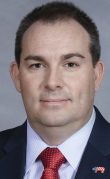
RALEIGH — A bill that started out as an effort by Sen. Harry Brown, R-Onslow, to limit the areas available for wind energy projects won’t be taken up again this session, the senator told a state court last week.
Brown, the Senate majority leader, testifying before a three-judge panel in Raleigh during a partisan redistricting trial, used the bill’s lack of progress as an example of when even powerful members of the legislature don’t get their way.
Supporter Spotlight

“To be honest with you the bill is going to die in the House,” he said on the stand under questioning from counsel for the legislative defendants. “I’ve worked it as hard as I can work it this year, but I can’t get that bill done just because I don’t have the support in the House to get it passed,” Brown testified.
The pronouncement was a blunt admission that the legislation would not surface again in the House even after a compromise to move the bill had been worked out earlier this session.
House Majority Leader John Bell, R-Wayne, said Brown’s assessment is accurate given that it is unlikely that a deal between the House and Senate can be reached this session.
Bell said there was enough pushback on a version passed June 24 by the House Committee on Energy and Public Utilities to convince him that a deal can’t be worked out this session.
Bell said he expected to revisit the bill during the legislature’s short session next year.
Supporter Spotlight

Wind energy advocates, including the North Carolina Sustainable Energy Association, or NCSEA, said they were relieved to hear the bill wouldn’t be taken up again this session.
“NCSEA, many legislators, their constituents, especially landowners, are pleased to hear that Senate Bill 377 will not move forward; however, we will continue to discuss this topic and other important clean energy issues with legislators.” Peter Ledford, the main counsel for the group and a lead negotiator for the industry on the bill, said Friday in an emailed response.
The main hitch in the legislation for now is how much maps developed to show potential areas of conflict will play in the regulatory system for wind turbines.
In 2017, Brown pushed through an 18-month moratorium on wind energy projects while maps on potential conflicts with military operations were developed.
The moratorium ended Dec. 31, 2018. The maps, produced by the state Department of Commerce using research by Morrisville-based consultants AECOM, show conflicts in nearly all of eastern North Carolina and would automatically rule out large swaths of the state from consideration for wind energy projects.

The maps were posted to the General Assembly’s website in April. Brown had introduced Senate Bill 377, the Military Base Protection Act, in late March. The bill would have required the state to use the maps in any siting process and would have banned construction in areas listed as having conflicts. In effect, that would have eliminated nearly all of North Carolina east of Interstate 95 except for a small portion of Currituck County and most of New Hanover, Pender, Brunswick, and Columbus counties from consideration for wind energy projects.
The bill sparked a battle in the Senate between Brown and Sen. Bob Steinburg, R-Chowan, whose district includes a major wind farm that was built to supply energy to the grid that serves Amazon Web Service’s current and planned cloud data centers. Senate Bill 377 passed the Senate 25-19 with Steinburg voting against it.
At the time, Sen. Jim Perry, R-Lenoir, a cosponsor with Brown who was in charge of steering the bill through the Senate, called the bill a work in progress. That version included a three-year moratorium on wind projects, a move that was strongly opposed by wood products company Weyerhaeuser, one of the region’s largest landowners. The company owned some of the land under consideration for a wind energy project that fell apart after the 2017 moratorium was imposed. Weyerhaeuser officials said earlier this year that the moratoriums interfere with the property rights of the region’s landowners.
With prospects poor for passage in the House, Bell, Steinburg and Perry worked on a compromise, eventually coming up with a bill that eliminated the moratorium and provided a system that would reduce reliance on maps showing conflicts with military training routes while at the same time adding additional ways for project opponents to make their case.
After the successful committee vote in the House, Perry said it was a positive step forward, but Brown said he was disappointed and declined to say whether he would support the new version.
His statement during the trial last week ended any speculation that he might support it. Brown called the issue paramount for eastern North Carolina.
Bell said he still intends to work on the bill next year.
Under General Assembly rules, bills passed by one chamber remain viable for the entire two-year session. He said his main objective is to give the military, especially wing commanders, more input.
Bell said a bill he sponsored in 2013, already gives the military more input, but he’s open to adding to that, including using the maps in the permitting process and finding additional processes for input.
“My focus has been just like Harry’s, to protect the military,” Bell said.







